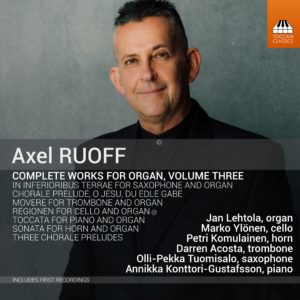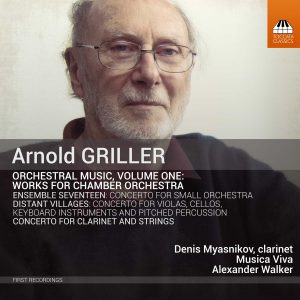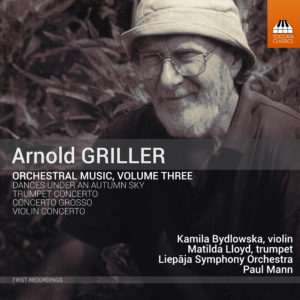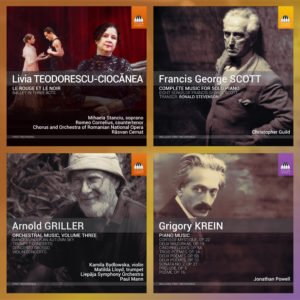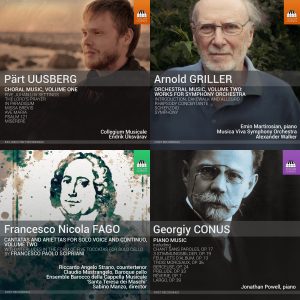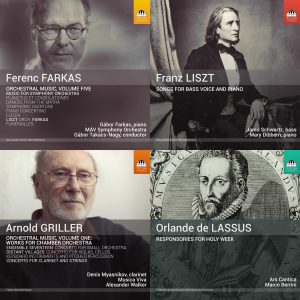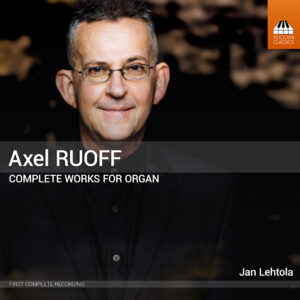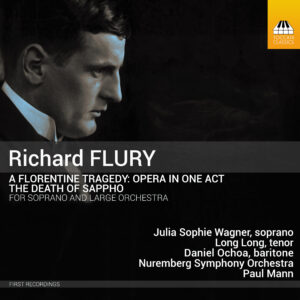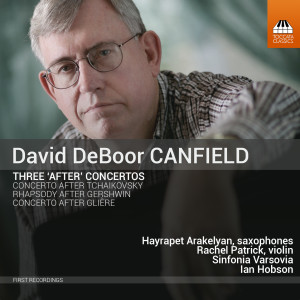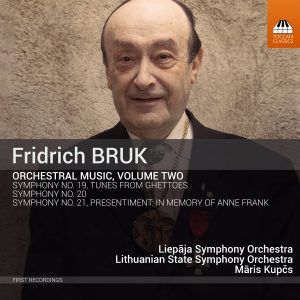Search Results for "saxo grill milk"
Axel Ruoff: Complete Works for Organ, Volume Three
The organ works of Axel Ruoff, born in Stuttgart in 1957, constitute one of the most important contributions to the literature for the instrument by any composer since Messiaen, with Ruoff often using its unparalleled resources to write music of extraordinary power and dramatic flair. This third volume in Jan Lehtola’s complete recording features the organ in the unusual role of duo partner in chamber music – but it is chamber music conceived on a symphonic scale. Here these five muscular duo works are separated by a series of weighty chorale preludes.
Annikka Konttori-Gustafsson, piano (Track 1)
Marko Ylönen, cello (Track 3)
Olli-Pekka Tuomisalo, saxophone (Track 5)
Petri Komulainen, horn (Tracks 9–11)
Jan Lehtola
organ of Sovituksenkirkko, Hollola, Finland (Track 1)
organ of St Michael’s Church, Turku (Tracks 2, 4, 6, 8–11)
organ of St Paul’s Church, Helsinki (Tracks 3, 5)
Arnold Griller: Orchestral Music, Volume Two
The composer Arnold Griller (b. 1937), son of the violinist Sidney Griller, grew up in London, surrounded by some of the world’s best-known musicians. In spite of this propitious beginning to his career, his considerable output remains largely unknown. This second volume of orchestral pieces presents four major works, not least Griller’s only symphony. His music is highly individual: it absorbs a number of disparate influences, not least Milhaud (his main teacher) and late Stravinsky, shows an occasional touch of the surreal and the bizarre, and infuses the result with radiant lyricism, edgy humour and restless energy..
Emin Martirosian, piano
Musica Viva Symphony Orchestra
Alexander Walker, director
Arnold Griller: Orchestral Music, Volume One
The composer Arnold Griller (b. 1937), son of the violinist Sidney Griller, grew up in London, surrounded by some of the world’s best-known musicians. In spite of this propitious beginning to his career, his considerable output remains largely unknown. This first volume of orchestral pieces presents three of his major works – music that turns out to be highly individual, often moving unexpectedly between moods of excitement and drive, wry humour and deep emotion. His influences and interests range widely, from Domenico Scarlatti to such twentieth-century masters as Milhaud (his main teacher) and Stravinsky, and on to composers of today. Melodic lyricism, rhythmic intensity, textural clarity and contrapuntal complexity combine with a generosity of musical ideas to produce a unique style and voice.
Denis Myasnikov, clarinet (Tracks 2 – 4)
Musica Viva
Alexander Walker, conductor
Arnold Griller, Orchestral Music, Volume Three
Three recent works by the English composer Arnold Griller (b. 1937) are joined here by the earliest music he still acknowledges, the gentle and touching Concerto Grosso for string orchestra (1955), which is informed by a serenity and wisdom uncommon in such a young composer. Like Berg’s Violin Concerto, Griller’s (2017) was born of his response to the loss of a young life, and shares Berg’s elegiac awareness of dying beauty; the Trumpet Concerto (2018), by way of deliberate contrast, accumulates energy and vivacity as it proceeds. Dances under an Autumn Sky (2017), subtitled ‘Orchestral Music in Six Scenes’, is a balletic blend of joie de vivre and intense instrumental drama, which shares Stravinsky’s fondness for rhythmic surprises and Tippett’s for angular, primal energy.
Kamila Bydlowska (violin)
Matilda Lloyd (trumpet)
Liepāja Symphony Orchestra
Paul Mann (director)
Ronald Stevenson: Music for Accordion
Ronald Stevenson (1928–2015) is best remembered for his huge output of music for the piano, an instrument he played with a rare understanding of tonal colour. It was thus entirely within character that he responded enthusiastically to the opportunity to explore the musical possibilities of the accordion, most impressively in a ‘Dance Poem’ of some scale. Stevenson was also an inveterate transcriber, producing hundreds of piano versions of pieces written for other forces. Neil Sutcliffe here returns the compliment, transcribing one of Stevenson’s own piano works and five of his songs for accordion, pulling the classical world and Scottish traditional music a little closer together.
Neil Sutcliffe, accordion
Michae O’Rourke, percussion
Rosie Lavery, soprano
January 2021 Bundle
Included in this bundle:
October 2018 Bundle
Included in this bundle:
October 2017 Bundle
Included in this bundle:
Linda Kouvaras: Instrumental Music, Chamber Works and Songs, Volume One
As with many other Australian composers, the music of Linda Kouvaras (b. 1960) has a strong sense of wide-open spaces, expressed in lyrical, elegiac melodic lines that soar over freewheeling Lisztian piano textures and atmospheric echoes of French Impressionism. In this first album of a series presenting all of her instrumental works, chamber music and songs written since 1991, she also addresses two major contemporary issues, with a duo for saxophone and piano exploring the human response to the COVID-19 pandemic and a song-cycle confronting domestic violence from a woman’s viewpoint.
Justin Kenealy, saxophone
Linda Barcan, mezzo-soprano
Coady Green, piano
Axel Ruoff: Complete Works for Organ
The organ works of Axel Ruoff, born in Stuttgart in 1957, constitute one of the most important contributions to the literature for the instrument by any composer since Messiaen. Stylistically, his music unites the French cathedral tradition of composers like Langlais, Dupré and Guillou with the concern with counterpoint and logic heard in Reger and later German figures. Ruoff uses the unparalleled resources of the modern symphonic organ not produce music of freewheeling energy and uncompromising power.
Jan Lehtola, organ
5 CD Box Set Includes:
TOCC0567 – Axel Ruoff: Complete Works for Organ, Vol. 1
TOCC0596 – Axel Ruoff: Complete Works for Organ, Vol. 2
TOCC0610 – Axel Ruoff: Complete Works for Organ, Vol. 3
TOCC0672 – Axel Ruoff: Complete Works for Organ, Vol. 4
TOCC0709 – Axel Ruoff: Complete Works for Organ, Vol. 5
Richard Flury: A Florentine Tragedy: Opera in One Act
The Swiss composer Richard Flury (1896–1967) felt the fascination for A Florentine Tragedy, Oscar Wilde’s drama of love and violence in Renaissance Italy, that also attracted his near-contemporary Alexander Zemlinsky: they set the same libretto. Flury responded to the text with this dark and swirling one-act verismo opera, sizzling with sexual tension, the vocal lines of the three characters unfolding over an orchestral texture remarkable for its plasticity and kaleidoscopic colour. It is preceded here by a dignified but impassioned operatic scena setting Grillparzer’s dramatic treatment of the suicide of the Greek poetess Sappho.
Julia Sophie Wagner (soprano), Tracks 1-3, 5-11
Long Long (tenor), Tracks 2-11
Daniel Ochoa (baritone), Tracks 2-11
Nuremberg Symphony Orchestra
Paul Mann (conductor)
Igor Raykhelson: Jazz Suite and other works
In the words of his friend the violist and conductor Yuri Bashmet, the composer-pianist Igor Raykhelson – born in Leningrad in 1961 and now resident in New York – 'possesses a superb mastery of both classical and jazz idioms’. The highly individual fusion of styles that results, Bashmet continues, 'elevates his music over that of many other composers creating in the genre often referred to as “crossover”’. The Jazz Suite on this CD exhibits Raykhelson’s popular style at its most infectiously catchy; the other three works here – in the Russian tradition of writing for strings initiated by Tchaikovsky – present the more classical side of his muse.
Igor Raykhelson, piano
Yuri Bashmet, viola, conductor
Elena Revich, violin
Igor Butman, saxophone
Yuri Golubev, double-bass
Eduard Zizak, drums
Moscow-Soloists, ensemble
Roland Szentpáli: Three Concertos
This album features three concertante works by the Hungarian composer Roland Szentpáli (b. 1977) for symphonic wind band: a virtuoso tuba concerto, with the composer as soloist; a rhapsody featuring clarinet, saxophone and the smoky tones of the tárogató, a folk instrument that sounds like a feral clarinet; and a double concerto in which Szentpáli takes up the saxhorn. The infectious rhythmic drive of all three works has its origins in the same folk traditions that inspired Bartók, and the scoring has the wallop of the big-band sound – and the solo performances are nothing less than astonishing.
Roland Szentpáli, bass tuba (Tracks 1 – 3), bass saxhorn (Tracks 5 – 7)
Bence Szepesi, clarinet (Tracks 4), soprano saxophone (Tracks 4 – 7, tárogató (Track 4)
Győr Symphonic Band
(Artistic Director: Ferenc Szabó)
László Marosi, conductor
David DeBoor Canfield: Three ‘After’ Concertos
David DeBoor Canfield, born in Florida in 1950, is an unusual composer: as well as writing music in his own contemporary style, he also ventures back into history, generating works that the major figures of the past might have produced had they written for particular instruments. Here are three examples from what he calls his ‘After’ series: saxophone concertos in the styles of Glière and Tchaikovsky and a violin rhapsody that might have flowed from the pen of Gershwin.
Hayrapet Arakelyan, saxophones
Rachel Patrick, violin
Sinfonia Varsovia
Ian Hobson
Timothy Roberts: Portraits, Distillations and Soundgames
Timothy Roberts, born in Hampstead, north London, in 1953, has been a mainstay of the early-music scene in Britain and further afield for decades. He is best known as a keyboard player, but in recent years composing has been of growing importance to him. Hardly surprisingly, his music refracts the Baroque and Classical world in which he is active, usually with a playful but respectful twist.
Jeremy West, cornett (tracks 1–13, 17–23)
Timothy Roberts, harpsichord (tracks 2–15), piano (tracks 11–16), clavichord (track 14), organ (track 22)
His Majestys Sagbutts & Cornetts (tracks 5–10)
Katy Bircher and Andrew Crawford, Baroque flutes (tracks 18–21)
Gail Hennessy and Hilary Stock, oboes da caccia (tracks 18–21)
Mike Gingold, alto saxophone (track 24)
Charles Daniels, tenor (track 27)
Digital compositions (tracks 24, 26–28)
Fridrich BRUK: Orchestral Music, Volume Two
Fridrich Bruk – born in Kharkov in 1937 and a Finnish resident since 1974 – made his name as a composer of tangos. But the heart of his music lies in a series of (to date) 21 symphonies, which have a strong narrative element, some reflecting Jewish themes, others inspired by Karelia and Finland. The three most recent together form a kind of meta-symphony premised on the persecution of the Jews in the first half of the twentieth century. Bruk’s kaleidoscopic use of orchestral colour, his angular but expressive melodies and his dramatic musical language reflect this urge to chronicle the outrage visited on his fellow Jews – and which directly impinged on his own life.
Liepāja Symphony Orchestra (Tracks 1-3, 7-8)
Arvydas Kazlauskas, baritone saxophone (Tracks 1-3)
Lithuanian State Symphony Orchestra (Tracks 4-6)
Māris Kupčs, conductor
First recordings
Stay In the Know
JOIN THE TOCCATA NEWSLETTER
"*" indicates required fields
By visiting our site, you agree to our privacy policy regarding cookies, tracking statistics, etc.
